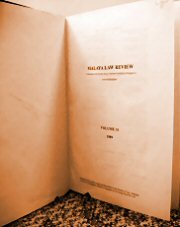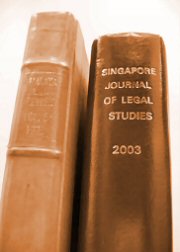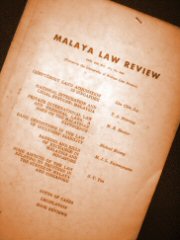|
Archive |
2386 records match your query:
| 171. | SEPTEMBER 2017 Issue | p.299 | |
| | The Impact of NUS Law on the Development of Tort Law in Singapore 299
Margaret Fordham • [2017] Sing JLS 299 (Sep)Tan Keng Feng, who died in December 2016, was a member of NUS Faculty of Law for over 30 years until his retirement in 2005. Professor Tan introduced generations of students to Tort Law. This compilation of papers to mark the 60th anniversary of the Law Faculty provides a timely opportunity to pay tribute to our colleague by examining the Faculty's influence (both direct and indirect) on the development of Tort Law in this jurisdiction.
| | 172. | SEPTEMBER 2017 Issue | p.308 | |
| | NUS Law's IP Journey, 1957-2017
Ng-Loy Wee Loon • [2017] Sing JLS 308 (Sep)The narrative of this piece is a simple one: the IP journey of NUS Law closely mirrors the IP journey of Singapore. If IP teaching barely featured at NUS Law for almost the first half of its history, this was when IP was unimportant in the old economy of Singapore and in fact the political leaders were even suspicious about IP rights. If IP teaching started at NUS Law in 1985, this coincided with Singapore shifting gears in the 1980s to move up the value chain into higher-technology sectors where IP rights matter. If NUS Law broadened and deepened its IP curriculum over the next three decades, this was in tandem with Singapore's construction of an increasingly sophisticated IP infrastructure that is needed for a new knowledge-based economy. This narrative is a tale of how a national law school played a supportive role in nation building.
[Full Text]
| | 173. | SEPTEMBER 2017 Issue | p.318 | |
| | The Importance of Criminal Law
Kumaralingam Amirthalingam • [2017] Sing JLS 318 (Sep)The Faculty of Law, National University of Singapore has been deeply involved in the teaching, research and practice of criminal law in Singapore since its early days. Pioneer members of the faculty developed teaching and resource materials which subsequent generations of scholars have built on. This paper charts the evolution of teaching at the law school and highlights the centrality of criminal law to the teaching and practice of law as well as our conceptions of justice. Criminal law has a profound impact on law students, and at NUS Law, it is a matter of pride that its students have an equally profound impact on criminal law in Singapore—as students, practitioners and leaders.
| | 174. | SEPTEMBER 2017 Issue | p.329 | |
| | Student Pro Bono and the NUS Faculty of Law
Helena Whalen-Bridge • [2017] Sing JLS 329 (Sep)Pro bono has changed radically in Singapore over the past 60 years, emerging from relative obscurity to become an important regulatory and educational issue. NUS Law has contributed to the growth of pro bono in Singapore through student pro bono. Currently these student activities are not limited to supporting the pro bono of lawyers and organisations, and they contribute directly to access to justice by providing the public and litigants in person with legal information. The character of student pro bono at NUS Law therefore suggests a shift in focus, from pro bono to the primary goal of access to justice.
| | 175. | SEPTEMBER 2017 Issue | p.345 | |
| | The UK Supreme Court Decision in The Res Cogitans and the Cardinal Role of Property in Sales Law
Michael Bridge • [2017] Sing JLS 345 (Sep)The decision of the United Kingdom Supreme Court in The Res Cogitans has had a profoundly upsetting impact on the law of sale of goods, upsetting many decades of a common understanding about the nature of a sale of goods contract. In a contract for the supply of bunker fuels, the supplier reserved the property in the goods but permitted the shipowner to consume the bunkers before payment and therefore before the property was intended to pass. This supply contract, moreover, was the fourth in a series of contracts on broadly similar terms. The contract was held not to be one of sale of goods because it did not require the property in the bunkers to pass to the shipowner. In reaching this outcome, the court remitted this type of supply contract to the common law, giving rise to a series of potential problems highlighted in this article. The litigation was sparked by the question whether the supplier could maintain a debt action for the price of the goods. In holding that the contract was not one of sale, the court was able to give the supplier its price action without being confined by the apparent limitations on such an action as laid down in the Sale of Goods Act and as expressed at earlier stages in the litigation. Dicta in the Supreme Court, however, have broadened significantly the circumstances in which a sale of goods action for the price may be maintained. Had the broader availability of the price action been decided earlier in the litigation, we should probably not have arrived at the conclusion that this contract was not one of sale of goods.
| | 176. | SEPTEMBER 2017 Issue | p.366 | |
| | Property in Bribes Revisited in a Cross-Disciplinary Perspective
Tan Yock Lin • [2017] Sing JLS 366 (Sep)Taking its point of departure from the decision of the United Kingdom Supreme Court in FHR European Ventures, this article seeks to bring cross-disciplinary perspectives to bear on the question whether an agent should hold the bribe he has received on constructive trust for his principal. Economising models are employed and the results interpreted by reference to the Calabresi and Melamed tripartite scheme of property rule, liability rule and inalienable right. The results are at least three-fold. First, an effective legal rule responding to the problem of harm caused by corruption must recognise and take account of differences between competitive and non-competitive environments and auditing or monitoring possibilities. Second, a property rule fails to do that. Third, ignoring such endogenous and exogenous variables, it overestimates or underestimates the harm suffered by victims of corruption.
| | 177. | SEPTEMBER 2017 Issue | p.383 | |
| | Book Reviews: Constitutionalism and Legal Change in Myanmar by Andrew Harding and Khin Khin Oo, eds
Alex Batesmith • [2017] Sing JLS 383 (Sep)On 29 January 2017, one of Myanmar's most noted constitutional lawyers and legal adviser to Aung San Suu Kyi's ruling National League for Democracy ("NLD") was shot dead in broad daylight atYangon International Airport. Coming only three days after the publication of Constitutionalism and Legal Change in Myanmar (2017), U Ko Ni's shocking assassination graphically highlighted the ongoing fragility of the transition to democracy and the perils continuing to face those who speak out for constitutional reform, human rights and the rule of law in one of South East Asia's most complex countries. The cautious optimism advocated by Daw Suu in the wake of the NLD's election victory in November 2015 has in the intervening two years been increasingly tested. The political power still evidently wielded by the military, continuing sporadic armed conflict in the ethnic states despite the nationwide ceasefire agreement, and international condemnation of widely reported allegations of government-perpetrated mass human rights violations in Rakhine State have all strained Myanmar's nascent democratic credentials.
| | 178. | SEPTEMBER 2017 Issue | p.387 | |
| | Book Reviews: A History of the Philosophy of Law in the Common Law World 1600-1900
Michael Lobban • [2017] Sing JLS 387 (Sep)The historical surveys of common law legal theory provided by volumes 8 and 11 of Springer's multi-volume Treatise of Legal Philosophy and General Jurisprudence have now been published in paperback, at a price which makes them more accessible to a wider readership. Michael Lobban takes us from the seventeenth century through to the dawn of the twentieth, and Gerald Postema surveys developments in the twentieth century. Significantly, the latter volume is well over double the length of the former, attesting to the explosion of theoretical reflection in the common law world over the last century. Postema mentions (at p xxv) that the book took him ten years to write and even in that period the pace of change was such that received ideas became a moving target.
| | 179. | SEPTEMBER 2017 Issue | p.387 | |
| | Book Reviews: Legal Philosophy in the Twentieth Century: The Common Law World
Andrew Halpin • [2017] Sing JLS 387 (Sep)Optimism or pessimism over the realisation of a jurisprudential ideal is a matter for personal temperament and inclination, but the efforts in the common law world across four centuries to engage in theoretical reflection over law and law's deeper connection to the fulfilment of social life amount to compelling evidence in reaching the conclusion that law cannot be reduced to an unreflective practice of lawyers. Every thinking lawyer should be informed and stimulated by these books, and as for the iurisperiti, any unthinking lawyers should acquire them in order to stimulate thought.
| | 180. | SEPTEMBER 2017 Issue | p.391 | |
| | Book reviews: The Commercial Appropriation of Fame: A Cultural Analysis of the Right of Publicity and Passing Off by David Tan
Peter Jaszi • [2017] Sing JLS 391 (Sep)Over several centuries, the rhetoric of 'gap filling' has often been invoked to naturalise expansions of intellectual property ("IP") rights—copyright term extension, the patenting of life forms, trademark disparagement, and so forth. The ready pragmatism of the phrase has definite audience appeal, making big changes sound like straightforward responses to external conditions—rather than choices about how to draw the line between private ownership and public discourse. We know, however, that once filled, 'gaps' tend to stay filled. Retrospective debates about the wisdom of such decisions tend to be (both literally and figuratively) of merely academic interest. So what is most refreshing and commendable about Professor Tan's The Commercial Appropriation of Fame is that the author's thorough and clear-eyed review of one such gap-filling project is powerful and timely enough that it could make a practical difference. Professor Tan not only tells us all we need to know about the historical origins of legal protection for celebrity personas, but also suggests a way that the scope of such protection can be reasonably cabined, in ways that largely fulfil the public interest in access to information, in years to come. This is all the more true because in the United States ("US") (with which Professor Tan is largely concerned), and elsewhere, the right of publicity and its cognates are largely creatures of the courts—common law improvisations which (even where they have received statutory confirmation) are still widely open to judicial interpretation.
| |
|
|


 |







